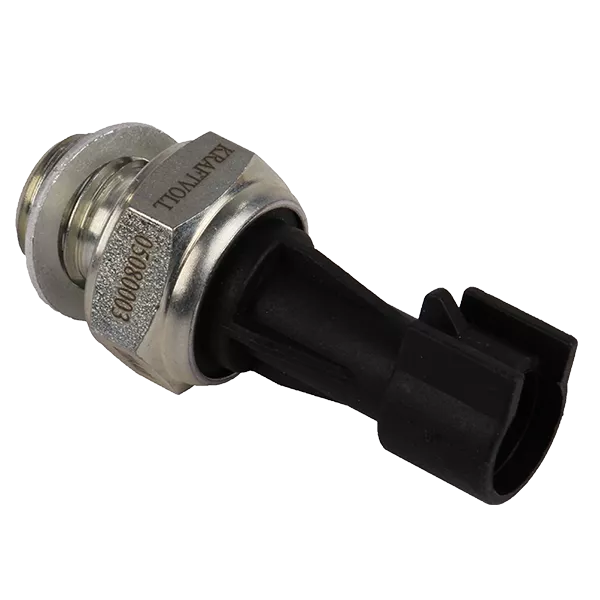Electronics
Sensor
Oil sensor;
The term "oil sensor" usually refers to a sensor that measures a vehicle's engine oil pressure. Engine oil pressure is important to ensure that the oil in an engine is circulating at a healthy level to reduce friction between parts and keep the engine running properly. Oil sensors measure this pressure and provide information to the driver or other systems in the vehicle. Here are some of the key features of an oil sensor:
1. Pressure measurement: Oil sensors typically measure the pressure of the engine oil in the system. This pressure is monitored to ensure that the oil in the engine is circulating properly and reducing friction between parts.
2. Pressure Gauge or Indicator Light: When the oil pressure drops, a pressure gauge or indicator light alerts the driver. This allows the operator to recognize a drop in engine oil pressure and address potential problems immediately.
3. Alarm and warning systems: Advanced oil sensors can alert the driver or relay information to other systems in the vehicle when critical oil pressure levels are exceeded.
4. Durability: Oil sensors are typically made of durable materials because they can be exposed to harsh conditions in the engine environment.
5. Integration capability: Some oil sensors can be integrated with other vehicle systems. This enables data sharing to monitor overall vehicle performance and quickly identify problems.
6. Accuracy: Accuracy is important in temperature measurement, so heat sensors are usually high-precision sensors. Heat sensors are commonly found in automobiles and other motor vehicles and are used to warn the driver or protect vehicle systems in the event of engine overheating. Each vehicle make and model may use different temperature sender depending on the technology and systems used. Therefore, their features and operating principles may vary depending on the vehicle type.
Reverse gear sensor;
The term "reverse gear sensor" usually refers to a sensor that detects when a vehicle is shifted into reverse gear. This type of sensor detects when the vehicle has shifted into reverse and provides information to various systems. Here are some key features of reverse gear sensor:
1. Reverse Gear Detection: Its basic function is to detect when the vehicle is shifted into reverse gear. This is usually accomplished through a transmission sensor or by signals from the gearbox.
2. Integration with Vehicle Control Systems: Reverse gear sensors can integrate with the vehicle's electronic control systems. This integration can provide information to various systems of the vehicle (e.g. parking sensors, camera systems).
3. Parking Assist and Parking Sensors: Reverse gear sensor can assist the driver during the parking process, often working in conjunction with parking assist and parking sensors systems.
4. Warning Systems: A sensor that detects when the vehicle is shifted into reverse can send a warning to the driver or other systems within the vehicle. This can help prevent accidents and improve safety.
5. Operational Durability: Often designed to withstand the elements, reverse gear sensors ensure reliable vehicle operation under a variety of conditions.
6. Precision: Reverse gear sensors must be able to accurately detect the moment of shifting into reverse gear. Reverse gear sensor can help improve driving safety, especially when used with modern driving assistance systems such as parking assist, parking sensors and reversing cameras. Each vehicle's reverse gear sensor can be different, so depending on the technology used and the make and model of the vehicle, its features may vary.
Brake sensor;
The term “brake sensor” refers to a sensor that monitors the status of the brake light, usually connected to a vehicle's braking system. This sensor is used to activate the brake light when there is a problem with thebraking system or when the driver depresses the brake pedal. Here are some key features of brake light sender in general:
1. Brake Status Detection: Brake light sensors can monitor conditions such as the brake pedal being depressed or the detection of a certain condition in the brake system.
2. Brake Light Control: This sensor is used to activate the vehicle's brake light when it detects a problem with the brake system or when the driver depresses the brake pedal.
3. Driver Alert: The brake light sensors can warn the driver if there is a problem with the brake system or if the brake light is activated. This can help the driver recognize a potential safety issue.
4. Integration with Electronic Control Units: In modern vehicles, brake light sensors can integrate with the vehicle's overall electronic control systems. This allows for coordinated operation with other systems in the vehicle.
5. Durability: Brake light sensors are often made from durable materials that are designed to withstand harsh vehicle conditions.













Founded in Germany in 2012, Kraftvoll Germany is an automotive spare parts brand registered in Türkiye and worldwide within the framework of the Madrid protocol. Headquartered in Munich, Krafvoll Germany's logistics warehouse also operates in Munich.
Copyright © KRAFTVOLL 2024 Tüm Telif Hakları Saklıdır